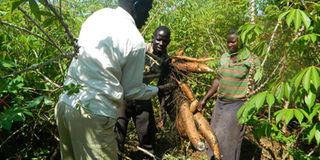South Sudanese refugee reaps from cassava farming

Harvesting. Mr William Lemi Minga (left) harvests cassava in his garden at Maaji III Settlement Camp, Adjumani District, in December 2018. PHOTO BY BILL OKETCH
What you need to know:
- Simsim. The family planted sesame, commonly called simsim, and fetched five sacks after harvesting the crop.
- Profits. They planted cassava and soya beans on the same piece of land and got Shs2.1 million at the end of the year.
ADJUMANI. William Lemi Minga escaped the violence in South Sudan to Uganda with his two brothers in 2005.
He first settled at Nyumanzi Refugee Settlement in Adjumani District before being relocated to Maaji III Settlement Camp.
In 2007, the war survivor got married to a Ugandan woman; Jane Lemi, and the couple has since been blessed with five children.
“We were brought here (refugee settlement) in early December 2005. On arrival, I was given a piece of land measuring 15 x 30 metres by the host community,” Mr Lemi says.
During the first planting season in 2006, the family planted sesame commonly called simsim and fetched five sacks after harvesting the crop.
In 2016, they planted cassava and soya beans on the same piece of land and got Shs2.1 million that year.
Mr Lemi reveals that he has been using part of their hard-earned money to pay school fees for his five children and two brothers.
“One is in Senior Five and the other is doing accounting in Arua, so I am the one supporting their education. Through farming activities, I generate money to pay their school fees,” he says.
“As a farmer, I realised the land given to me by the host community was not enough for production, I decided to buy 15 acres of land from a friend at Shs3.5 million,” he adds.
Today, Mr Lemi like thousands of people uprooted by the conflict in South Sudan is keen to learn new farming technologies to help boost food production, income and ensure long-term livelihood security.
His family is among 25,226 households in the three sub-counties of Dzaipi, Pakele and Ukusijoni that have benefited from Adjumani Livelihoods Project supported by donors. The project covers Pagirinya, Ayilo II, Maaji II and Maaji III settlements.
Also, a total of 210 farmer groups have been supported under this intervention. The project further distributed 100 ox-ploughs and 200 oxen to 100 beneficiary farmer groups in the project area.
Mr Lemi, who was selected from the camp as a model farmer and trained in new farming techniques, shares his inspiring story with other beneficiaries.
“When World Vision came in, they took us for training in crop husbandry and later we were taken for a study tour at Namulonge [Research Institute] in Kampala,” Mr Lemi says.
“World Vision’s intervention has supported my family very well because whenever I go for any training, my life always changes. During the training, they tell us ‘you have to learn how to stay with people; you have to use the talent given to you to at least make your life better,” he reveals.
“So when I applied the knowledge I obtained from the training this year, I planted rice and harvested 60 sacks. World Vision also supported me with 10 sacks of clean cassava planting materials,” Mr Lemi says.
About the intervention
Unlike other interventions, Adjumani Livelihood Project is so unique. The project requires beneficiaries not simply to receive inputs such as oxen, ox-ploughs and seeds but to organise themselves in groups that engage in market-driven enterprises.
The beneficiaries are required and guided to produce, sell their produce and make money. The groups must also engage in savings. They must save as a group, lend to each other, borrow, pay back, keep records and meet every week.
“The ultimate goal of this project is to improve child’s wellbeing in Adjumani. We are linking our intervention from child protection to livelihood intervention, and livelihood contributes to child wellbeing – where children are well-nourished,” says Mr Lawrence Okello, a Monitoring and Evaluation manager.
Ms Jesca Alanyo, a livelihoods coordinator at World Vision, explains: “And the uniqueness with our project is that we give out foundation seeds for multiplication.” When the groups harvest their produce, the price at which they will be able to sell their seeds is slightly different because the cost of seeds is not the same as the cost of grains in the market, she adds.
“So for them (beneficiaries) they would have an advantage of having access to better market because of the fact that they are producing seeds, and they are not just producing grains for consumption.”
However, refugees and members of the host communities that have not tested the project are also in dire need of support.
Ms Alanyo agrees the concern is genuine. “And so we believe that we need to have multiplier effect of this kind of support. We just don’t have to limit ourselves only to the 25,000 households,” she says.
“If the 25,000 households are already doing well, we need to extend similar support to other people who have also not been able to benefit in this kind of arrangement.”


